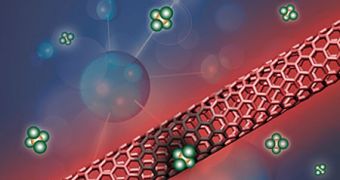A group of investigators based at the US Department of Energy's Los Alamos National Laboratory announces the development of a study technique that allows semiconducting carbon nanotubes to identify and track individual molecules through water.
This finding is extremely important due to the massive number of physical and chemical processes that are known to take place at the boundary between water and solid materials. What it all comes down to is knowing how individual molecules interact with each other.
Knowing this pattern could lead to a better understanding of numerous processes going on in nature. According to the LANL team, light-emitting cylinders of pure carbon called nanotubes can now be used to selectively identify and track individual molecules throughout such processes.
However, researchers using this approach need to have access to high-speed microscopic imaging capabilities, since the interactions are extremely fast. Plus, many of them take place simultaneously.
The most remarkable thing about this new research is that it provides a way for single molecules to be tracked down in water. Previously, in order to do that, scientists had to develop experimental setups that required the presence of space-like conditions.
This limitation eventually made water one of the least known chemicals out there, especially in terms of molecular dynamics and interactions at its surface. What researchers did figure out was that they needed a specialized detector to act as a proxy for such studies.
The LANL team developed the glowing carbon nanotubes as a direct response to this need. The work was carried out by Center for Integrated Nanotechnologies experts Jared Crochet, Juan Duque, Jim Werner, and Steve Doorn.
Details of their research appear in a paper entitled “Photoluminescence imaging of electronic impurity-induced exciton quenching in single-walled carbon nanotubes,” which was published in the latest online issue of the esteemed journal Nature Nanotechnology.
The approach works by bombarding the nanotubes with laser light of a specific wavelength. When the small tubes attach themselves to a molecule bombarding the water surface, their tips momentarily become less luminous, and this brightness variation can easily be detected with high-speed microscopy.
This investigation was sponsored by the Center for Integrated Nanotechnologies, which is a user facility operated by the DOE Office of Basic Energy Sciences.

 14 DAY TRIAL //
14 DAY TRIAL //